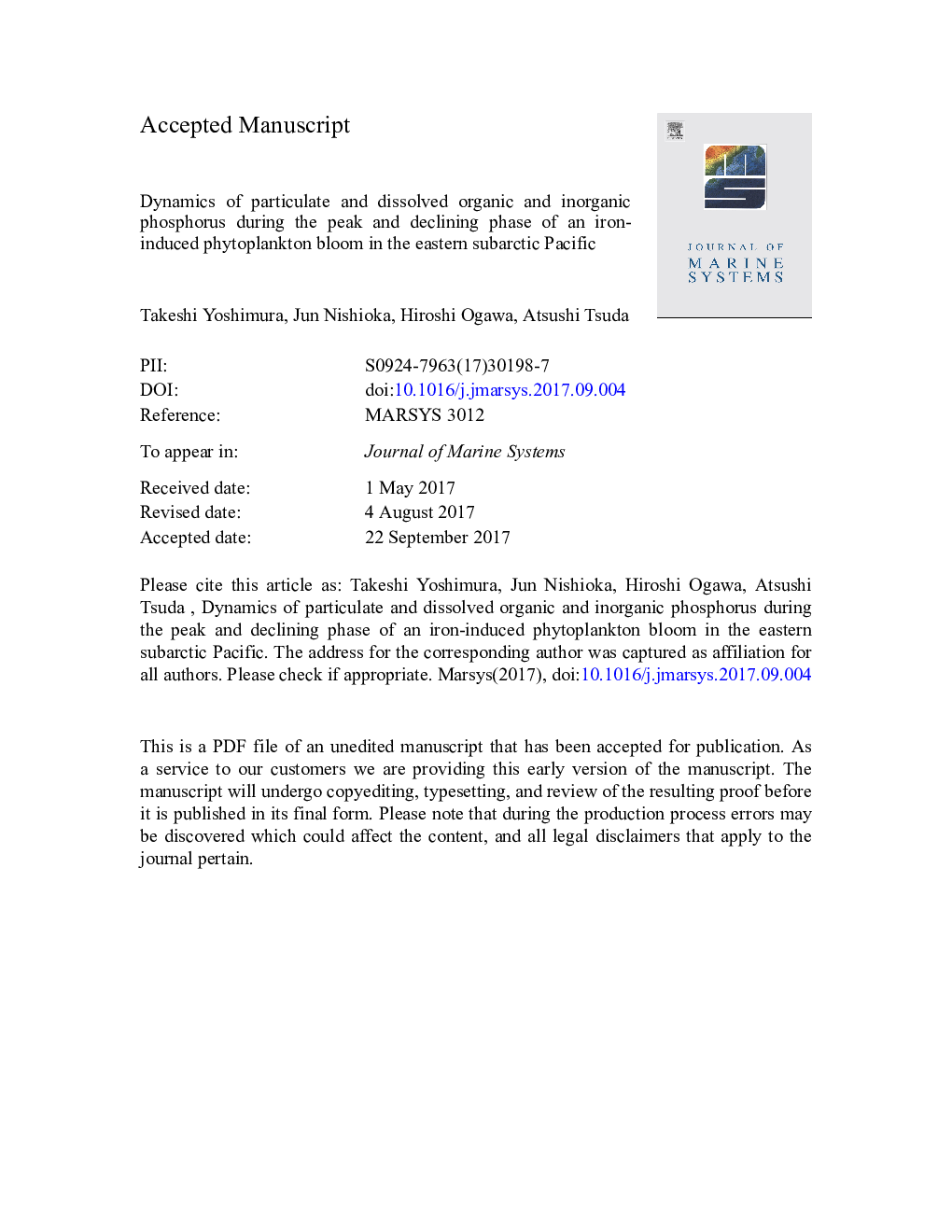| کد مقاله | کد نشریه | سال انتشار | مقاله انگلیسی | نسخه تمام متن |
|---|---|---|---|---|
| 5766003 | 1627253 | 2018 | 33 صفحه PDF | دانلود رایگان |
عنوان انگلیسی مقاله ISI
Dynamics of particulate and dissolved organic and inorganic phosphorus during the peak and declining phase of an iron-induced phytoplankton bloom in the eastern subarctic Pacific
ترجمه فارسی عنوان
دینامیک فسفر آلی و معدنی منیزیم و فسفری در فاز پیک و فاز فیتوپلانکتون ناشی از آهن در ساحل دریای اقیانوس آرام
دانلود مقاله + سفارش ترجمه
دانلود مقاله ISI انگلیسی
رایگان برای ایرانیان
کلمات کلیدی
فسفر، مواد ارگانیک، ماده معدنی، شکوفه فیتوپلانکتون،
موضوعات مرتبط
مهندسی و علوم پایه
علوم زمین و سیارات
اقیانوس شناسی
چکیده انگلیسی
Phosphorus (P) is an essential element for all organisms and thus the P cycle plays a key role in determining the dynamics of lower trophic levels in marine ecosystems. P in seawater occurs conceptually in particulate and dissolved organic and inorganic (POP, PIP, DOP, and DIP, respectively) pools and clarification of the dynamics in these P pools is the basis to assess the biogeochemical cycle of P. Despite its importance, behaviors of each P pool with phytoplankton dynamics have not been fully examined. We measured the four operationally defined P pools (POPop, PIPop, DOPop, and SRP) during an iron-induced phytoplankton bloom (as part of the subarctic ecosystem response to iron enrichment study (SERIES)) in the eastern subarctic Pacific in summer 2002. During our observations of the iron-enriched patch from day 15 to day 26 after the iron infusion, chlorophyll-a concentration in the surface layer decreased from 6.3 to 1.2 μg Lâ 1, indicating the peak through decline phase of the phytoplankton bloom. At the bloom peak, P was partitioned into POPop, PIPop, and DOPop in proportions of 60, 27, and 13%, respectively. While chlorophyll-a and POPop showed similar temporal variations during the declining phase, PIPop showed a different peak timing with a 2 day delay compared to POPop, resulting in a rapid change in the relative proportion of PIPop to total particulate P (TPP = POPop + PIPop) at the peak (25%) and during the declining phase of the bloom (50%). A part of POPop was replaced by PIPop just after slowing down of phytoplankton growth. This process may have a significant role in the subsequent regeneration of P. We conclude that measurement of TPP alone is insufficient to show the interaction between P and phytoplankton dynamics and fractionation of TPP into POPop and PIPop provides useful insights to clarify the biogeochemical cycle of P.
ناشر
Database: Elsevier - ScienceDirect (ساینس دایرکت)
Journal: Journal of Marine Systems - Volume 177, January 2018, Pages 1-7
Journal: Journal of Marine Systems - Volume 177, January 2018, Pages 1-7
نویسندگان
Takeshi Yoshimura, Jun Nishioka, Hiroshi Ogawa, Atsushi Tsuda,
